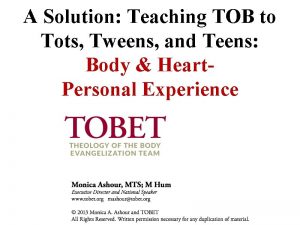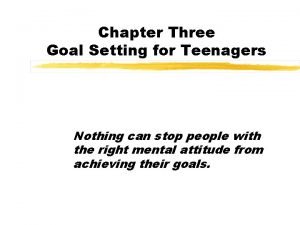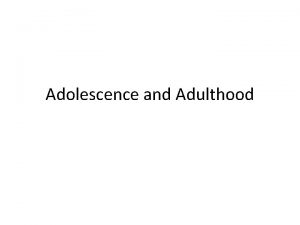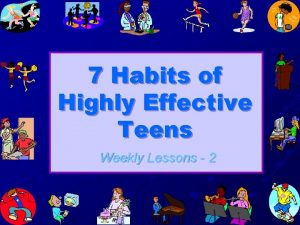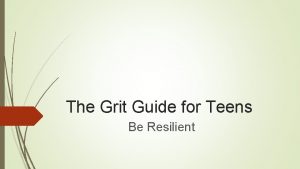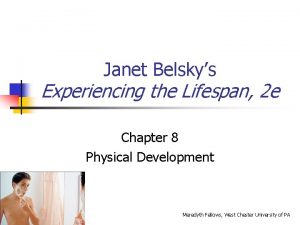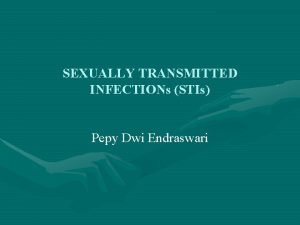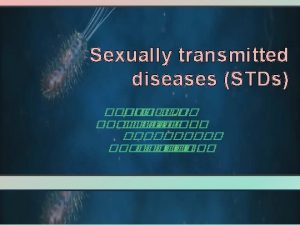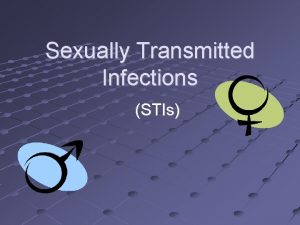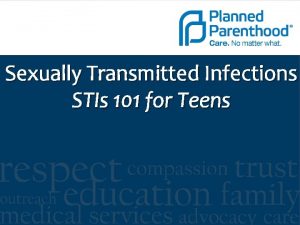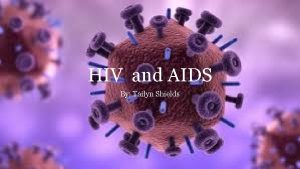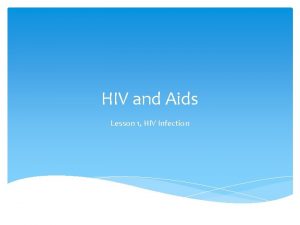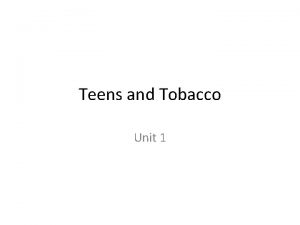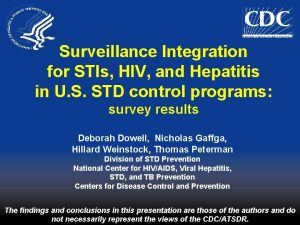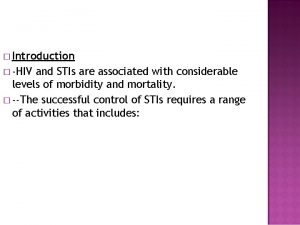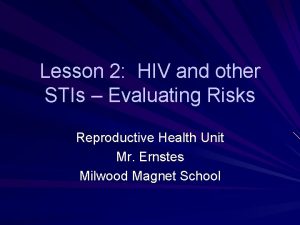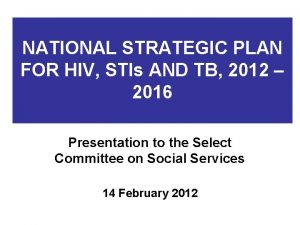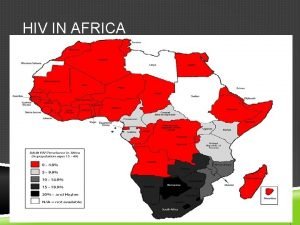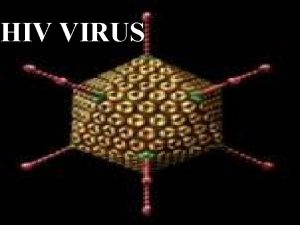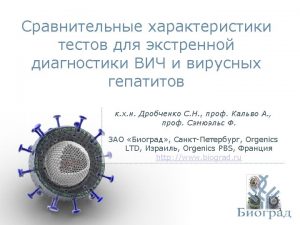How To Prevent HIV and STIs What Teens






















- Slides: 22

How To Prevent HIV … and STIs! What Teens Need To Know To Stay Healthy Sexual Health Education Program San Diego Unified School District

Group Agreements • Be respectful. • Use appropriate terminology. • Do not share personal information. • Raise your hand when asking or answering a question.

What Is HIV? • HIV = Human Immunodeficiency Virus • Transmitted via which fluids? * • Semen & pre-ejaculate fluid • Vaginal fluids • Blood • Breast milk • By doing what? * • Unprotected sex • Sharing needles *With someone already infected with HIV (AIDS. gov http: //aids. gov/hiv-aids-basics/hiv-aids-101/what-is-hiv-aids/)

What Does HIV Do Inside Your Body ? • HIV attacks a key part of your immune system – your CD 4 T-cells. • These T-cells fight infections and diseases in your body. • HIV invades these cells, uses them to make copies of itself, and destroys them! (AIDS. gov http: //aids. gov/hiv-aids-basicshiv-aids-101/what-is-hiv-aids/)

What Is AIDS? AIDS = Acquired Immune Deficiency Syndrome AIDS (SIDA) is a medical condition that occurs when HIV has severely weakened a person’s immune system, putting an HIV+ person at risk of developing opportunistic infections and could lead to death. * HIV can be transmitted from an infected person to another person. AIDS is a disease caused by HIV infection and is not transmitted to another person. (AIDS. gov http: //aids. gov/hiv-aids-basics/hiv-aids-101/what-is-hiv-aids/)

Why Are Teens At High Risk? 1 in 4 new HIV infections occurs in youth ages 13 to 24 years. • Not using condoms during sex • Low rates of HIV/STI testing • Drug and alcohol use (increases risky behavior) • Lack of access to health services • Weaker cells on young female’s cervix

Risk Level Activity

RATE the RISK Directions 1) You will receive a handout with a list of behaviors. 2) For each behavior, place a check mark in the column that you think best describes the risk level (high risk, low risk, or zero risk) of transmitting HIV/STI.

RATE the RISK Answers

How Can You Reduce the Risk of HIV/STI Infection? • Sexual abstinence 100% Effective! • Condoms • Monogamy • Avoiding multiple/much older sexual partners • Abstinence from intravenous drugs • Not sharing needles

REDUCE the RISK 1) Turn over your RATE the RISK worksheet. 2) Review the list of potential obstacles to safer behaviors that teens may face. 3) Next to each obstacle, write an appropriate response that could help someone overcome that obstacle.

Reflection 1) Why do you think it is important to consider the risk of transmitting HIV/STI? 2) What are some ways teens can better protect themselves? 3) What are some benefits of delaying sexual activity?

Risk in Perspective In 2019, for SDUSD juniors… § 63% abstained from sex § 51% used condoms if they did have sex § 49% did not use condoms when they had sex (2019 YRBS data) 1 in 2 sexually active young people… § Will get an STI before age 25 § Most will NOT KNOW they are infected (www. cdc. gov/gyt)

Condom Demonstration 1. Store in dark place away from heat and chemicals. 2. Use a new latex condom for each different sex act. 3. Check the expiration date. 4. Use only water-based lubricants. 5. Put condom on erect penis before any contact. 6. Roll to base of penis. Leave a ½ inch at the tip of the condom to collect the semen. Squeeze the tip to release air. 7. Remove immediately after ejaculation before it slips off. Avoid spilling contents. 8. Use consistently and correctly every time! Anyone may purchase condoms at any age without parental consent. Free condoms are also available confidentially from our School Nurse.

HIV Testing Conventional Blood Draw Rapid Test • Intravenous blood draw • Oral swab or finger prick • Results in 1 -2 weeks • Results in 20 minutes • Detects HIV exposure 6 weeks prior • Detects exposure 3 -6 months prior If you are sexually active, you should get tested at least once a year!

HIV Early Test If you are concerned that you might have been exposed to HIV within the past couple of weeks, there is a test available that can detect HIV infection in a person’s body as early as one week after exposure. Please ask a health provider for a referral to an agency that conducts this test. (AIDS. gov)

HIV Treatment as Prevention HIV+ people who take antiretroviral medications have normal life expectancies. • HIV+ people taking antiretrovirals have a much lower rate of transmitting the virus to other people. • HIV- people who are at high risk of contracting HIV (such as having an HIV+ partner) can take Pr. EP (Pre -Exposure Prophylaxis), a daily medication that is highly effective at preventing HIV. • HIV- people who think they have been exposed to HIV can go to an emergency room to get PEP (Post -Exposure Prophylaxis), a one-time medication that is highly effective at preventing HIV if exposed to it.

HIV Myths and Facts • People can transmit AIDS to one another. • MYTH – People can transmit HIV to another via blood or sexual fluids if one person already has HIV. AIDS is a medical condition that can develop in someone who has HIV and it cannot be transmitted between people. • Only gay men get AIDS. • MYTH – HIV can be transmitted between anyone who is exchanging blood or sexual fluids with someone who is HIV+. HIV transmission depends on behavior, not sexual orientation or gender. • If someone contracts HIV, they can live a normal life. • FACT – HIV+ people taking antiretroviral medications have normal life expectancies and their ability to transmit HIV to another person is drastically reduced.

STI Testing & Treatment STI Tests • Swab of discharge or sore/wart • Urine sample • Blood test • Throat swab Vaccines/Treatment • Human Papilloma Virus (HPV) recommended for males and females • Hepatitis B Virus (HBV) required before entering SDUSD • Anal swab • Prescription antibiotics, other medications • Pap test for females (for HPV) • Removal of warts/growths Be honest with your health provider about the types of sex that you are having (anal, oral, vaginal) so that they can administer ALL of the appropriate tests! If you are diagnosed with HIV/STIs, you MUST follow through with treatment completely!

Confidential Care You have a right to privacy and confidential sexual health care. • You can be tested and treated for HIV/STIs without parental notification or consent. • HIV/STI/contraception medical appointments can be made during school hours. See your School Nurse or Counselor for more details. • You can also obtain free condoms confidentially from our School Nurse. • Low or no-cost testing/treatment/contraception may be available through Family PACT. Sign up at a Health Clinic.

Remember… • There is NO CURE for HIV infection or AIDS! • Antiretroviral medication can keep HIV+ people healthy, with a normal life expectancy, and reduce their risk of transmitting the virus. • However … they must get tested, remain in treatment, and take their medications daily for the rest of their lives. • Testing is CRUCIAL! • You cannot rely on symptoms to know if you have HIV/STIs. • The ONLY way to know for sure if you are infected with HIV or an STI is to GET TESTED. • HIV AIDS • Open sores caused by Herpes and Syphilis provide way for HIV into bloodstream. • Once infected with STI, immune system is more susceptible to HIV. • Behaviors that can lead to HIV infection put you at greater risk for other STI infections!

ANY QUESTIONS? • Please raise your hand if you have a question for the educator. • You will receive a STUDENT SUPPORT CARD and a CA MINOR CONSENT LAW CARD. Please put them away in your wallet, purse, or backpack. • Take any additional pamphlets on your way out of class.
 Tots tweens and teens
Tots tweens and teens A-teens 사라 룸홀트
A-teens 사라 룸홀트 Nn teens
Nn teens Png
Png Nn teens
Nn teens Long term goals for teens
Long term goals for teens How does digital media try to hook you
How does digital media try to hook you 7 habits of highly defective teens
7 habits of highly defective teens Courage zone 7 habits
Courage zone 7 habits Quality time love language
Quality time love language Goal setting for teens
Goal setting for teens During early teens, what is reasoning like?
During early teens, what is reasoning like? 7 habits of highly effective teens quotes
7 habits of highly effective teens quotes Proactive vs reactive 7 habits
Proactive vs reactive 7 habits Qkeq-yvn8ew -site:youtube.com
Qkeq-yvn8ew -site:youtube.com 5 habits of highly effective
5 habits of highly effective 7 habits of highly effective teens habit 2
7 habits of highly effective teens habit 2 Project ideas for teens
Project ideas for teens Pance blueprint
Pance blueprint Love language test for teens
Love language test for teens Teens for unity
Teens for unity Nn teens
Nn teens Chapter 25 sexually transmitted infections and hiv/aids
Chapter 25 sexually transmitted infections and hiv/aids
